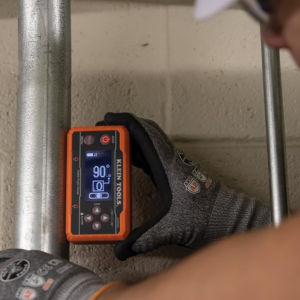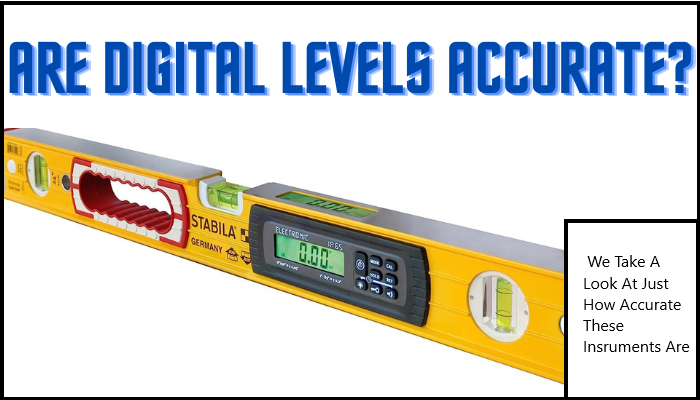In this article we answer the question: Are Digital levels accurate?
As a professional with over 30 years of experience under my toolbelt, I’ve used all kinds of levels over the years. From the old-fashioned bubble levels I started with as an apprentice to the fancy digital laser levels used on today’s complex jobsites.
When it comes to accuracy and reliability, I’ve found that digital levels can be incredibly precise tools – if you choose the right equipment and use proper technique. But they have some quirks and limitations that you need to understand to get the most out of them.
Contents
- 1 How Accurate Are Digital Levels?
- 2 A Quick Refresher – How Do Digital Levels Work?
- 3 Key Factors That Influence Accuracy
- 4 Laboratory Testing vs. Real-World Results
- 5 Techniques for Achieving Maximum Accuracy in the Field
- 6 The Pros and Cons of Digital Levels
- 7 Projects Where Digital Level Precision Matters Most
- 8 Conclusion – Accurate Digital Levels Take Skill
- 9 Frequently Asked Questions (FAQs) About Digital Spirit Level Accuracy
How Accurate Are Digital Levels?
In this in-depth guide, I’ll share everything I’ve learned through extensive hands-on use about how accurate digital levels really are in the field and what it takes to maximize that accuracy on your jobs.
A Quick Refresher – How Do Digital Levels Work?
Before we dig into the nitty gritty details on accuracy, let’s recap briefly how these high-tech levels do their job:
- Digital levels contain a precision gravity sensor or tiltmeter to detect orientation relative to level or plumb.
- An electronic microprocessor converts the sensor readings into easy-to-read digital measurements.
- The results are displayed clearly on a digital LCD with backlighting for easy viewing in any conditions.
- This takes the guesswork out of bubble-reading – the level does the work for you!
- Most units also include features like angle/slope mode, auto-calibration, and adjustable tolerances.
So in a nutshell, digital levels use technology to precisely measure, display, and analyze orientation and tilt. But what factors impact how accurate those readings really are?

Key Factors That Influence Accuracy
On paper, digital levels sound incredibly precise. But in practice out in the unpredictable field environment, there are a few variables that affect how closely those measurements match true level:
Sensor Sensitivity and Sampling Rate
The tilt sensor inside the level is central to accuracy. More advanced digital levels boast high sensitivity tilt sensors that offer faster sampling rates. This allows them to detect even minute deviations from level or plumb.
Cheap consumer-grade digital levels can have surprisingly mediocre sensors. I once used a bargain model that struggled to even register slight tilts! Needless to say, I upgraded to a pro-grade sensor after that experience.
Proper Calibration
Calibrating digital levels regularly is crucial for maintaining accuracy over time. Temperature fluctuations, shocks, vibrations, and damage can all throw off calibration little by little.
Digital levels calibrate themselves electronically rather than with physical adjusters. It’s important to run the calibration routine as specified by the manufacturer – for most models, monthly or before starting a large project. Even if it seems perfectly level, it’s worth the peace of mind!
Environmental Conditions in the Field
Since digital levels rely on sensitive electronic sensors, factors like temperature, humidity, vibration, and shock impact the sensor readings.
Most digital levels work great in normal indoor conditions year-round. But accuracy may decrease in extreme cold, heat, moisture, or vibration.
I once had to use a digital level in below-freezing temperatures on a job site. While it worked decently, the readings seemed off – so I switched back to a trusty old bubble level for the remainder of that frigid job!
Laboratory Testing vs. Real-World Results
When researching and choosing digital levels, you’ll notice impressive accuracy specifications like +/- 0.5 mm over 1 meter. But how is that lab-tested accuracy realized on an unpredictable construction site?
Based on my extensive field usage, here is how different types of digital levels have stacked up in terms of real-world results:
- Basic consumer-grade digital levels – Lab accuracy +/- 1-3mm. Real-world accuracy typically +/- 3-5mm under good conditions.
- Professional grade digital levels like Stabila – Lab accuracy +/- 0.5mm or better. Real-world accuracy +/- 1-2mm if properly calibrated and used.
- Advanced laser rotary levels – Lab accuracy of +/- 0.2mm or better. Real-world accuracy of +/- 1mm or better achievable.
As you can see, you get what you pay for in terms of both lab specs and on-site precision. And lab accuracy is often best case – real-world results depend on proper use in imperfect conditions.
Techniques for Achieving Maximum Accuracy in the Field
Through extensive daily use of digital levels, I’ve figured out some best practices for getting the highest accuracy possible on site:
- Frequent calibration – Don’t skip your calibration routine – this is #1!
- Work on stable, vibration-free surfaces – Ensure the level is placed on solid, even materials when in use.
- Level the actual level – Double check that the unit itself is precisely level before taking measurements.
- Take multiple readings – Check accuracy by taking 2-3 readings in a row and averaging the results.
- Be mindful of environmental conditions – Note the temperature, humidity, vibration – anything that could impact sensor readings.
- Invest in quality from reputable brands – Don’t waste money on the cheapest options – pay more for better sensor quality!
For example, I use a $600 professional-grade digital level regularly. The lab specs boast 0.3mm accuracy. By carefully calibrating and averaging 3-4 readings, I can easily achieve real-world precision within 1mm on my jobsites. Now that’s impressive for construction-grade work!
The Pros and Cons of Digital Levels
After using both simple bubble levels as well as advanced digital models extensively, I’ve found that each has its advantages and disadvantages:
Pros of Digital Levels
- Readings are far more precise than the human eye can discern from a bubble level
- Results are displayed digitally, eliminating bubble-reading guesswork
- Measurements can be taken much quicker than bubble levels
- Advanced models are incredibly precise, almost on par with commercial optical levels
Cons of Digital Levels
- Even mid-range models are considerably more expensive than basic bubble levels
- All digital levels require careful calibration and maintenance
- Accuracy limitations in certain job site conditions and temperatures
- Over-reliance on digital can lead to mistakes versus user skill with bubble levels
For all but the most precision-demanding projects, a good quality bubble level may still be perfectly suitable. But when utmost accuracy is required, digital comes out on top.

Projects Where Digital Level Precision Matters Most
Based on two decades of construction experience, these are the situations where I rely on my digital level’s utmost accuracy:
Foundation Work
Getting footings and stem walls perfectly level and plumb to start a structure off right – mistakes here get very expensive!
Finish Carpentry
Hanging doors, installing cabinets, fine trimwork – anything where tight tolerances make a noticeable difference in the final product.
Tiling Large Surfaces
Floors, walls, kitchen backsplashes, bath surrounds – flatness is crucial for proper coverage and professional results.
Concrete Work
Laser screeding, grading, and drainage depends on digital rotary lasers calibrated to precise site plans.
Zero Tolerance Alignments
Interior wall alignments, exterior excavation, assembly of prefab sections – no room for error!
So in summary, for perfectly-level-mandatory work like this where precision alignment is critical, invest in the best digital or laser level you can afford. That extra decimal place of accuracy makes all the difference.
For everyday rough work, my old trusty bubble levels still work just fine for most applications!
Conclusion – Accurate Digital Levels Take Skill
Today’s digital levels are incredible instruments – when selected properly and paired with experience and care, they can achieve amazing real-world precision.
But there are many pitfalls – cheap quality, improper calibration, careless use – that can lead to inaccurate readings and costly mistakes. Learn your tool inside out, choose professional quality, and use good technique.
Precision measurement takes not just accurate tools, but skill from years of practice. So invest in a professional grade digital level, take the time to master it, and let the results speak for themselves – accurately leveled floors, walls, foundations that impress every client.
At the end of the day, bubbles or digital, it’s still the carpenter’s skill, care, and experience that guarantee a job well done!
Frequently Asked Questions (FAQs) About Digital Spirit Level Accuracy
Q1: How does a digital spirit level work? A: Digital spirit levels utilize sensors, inclinometers, and gyroscopes to calculate precise measurements of inclinations and angles. Unlike traditional bubble levels, digital spirit levels display readings on a digital screen.
Q2: Are digital spirit levels accurate? A: Yes, digital spirit levels are generally accurate. However, their precision can be influenced by factors like calibration, sensor quality, environmental conditions, and user technique.
Q3: Can I trust user reviews to gauge accuracy? A: User reviews offer valuable insights into real-world experiences. While they can be helpful, it’s essential to consider a variety of sources and expert opinions to form a comprehensive understanding.
Q4: How often should I calibrate my digital spirit level? A: The frequency of calibration depends on the tool’s usage and manufacturer’s recommendations. In professional settings, regular calibration is crucial for maintaining accuracy.
Q5: Are camera-based digital spirit levels accurate enough for professional use? A: Camera-based digital spirit levels can be accurate for many applications, but they might have slightly lower precision compared to inclinometer or gyroscope-based models. Their suitability for professional use depends on the specific requirements of the job.
Q6: What are the advantages of digital spirit levels over traditional ones? A: Digital spirit levels offer faster readings, additional features like memory storage and angle measurements, and increased convenience due to digital displays.
Q7: Can extreme temperatures affect the accuracy of digital spirit levels? A: Yes, extreme temperatures can influence accuracy. It’s essential to consider the operating environment and make any necessary compensations for temperature variations.
Q8: How can I ensure accurate readings with my digital spirit level? A: To maximize accuracy, handle the tool with care, calibrate it regularly, choose the right model for the application, and consider cross-verifying readings with auxiliary equipment.
Q9: Will advancements in technology improve digital spirit level accuracy in the future? A: Yes, as technology continues to evolve, digital spirit levels are likely to see improvements in accuracy and reliability due to advancements in sensor technology and algorithms.
Q10: Can digital spirit levels be used for artistic purposes, like photography? A: Absolutely! Digital spirit levels are valuable tools for artists and photographers who seek precise framing, levelling, and composition in their creative work.



